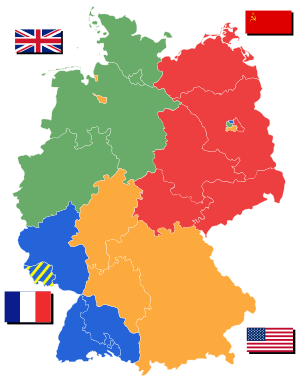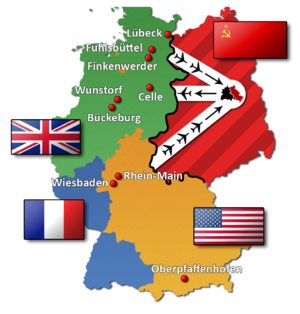Berlin Blockade facts for kids
The Berlin Blockade was a big event that happened in Berlin, Germany, from June 24, 1948, to May 11, 1949. It started when the Soviet Union stopped all railway and road travel for the Americans, British, and French into their parts of Berlin. These three countries were called the Western powers. The Soviets wanted to cut off supplies to West Berlin.
The Blockade ended when the Western powers used airplanes to fly in food and other important supplies. This amazing effort was called the Berlin Airlift. The Soviet Union began the blockade because they felt the Western parts of Germany were becoming too strong. They wanted the Western powers to leave their occupation zone.
Contents
Why was Germany divided after World War II?
After World War II, the Allied Powers (the United States, United Kingdom, Soviet Union, and France) met at Potsdam. They decided to divide Germany into four areas, called occupation zones. Each major Allied country controlled one zone. Berlin, the capital city, was also divided into four zones. However, Berlin was completely surrounded by the Soviet zone. This meant the only way to reach the Western-controlled parts of Berlin was by traveling through Soviet land.
What caused the Berlin Blockade?
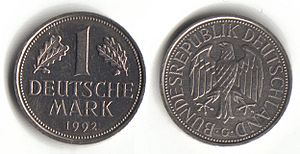
The Soviet Union started the blockade for a few reasons. They worried that the Western half of Germany was getting too powerful. This was because the Western powers had introduced a new currency, the Deutsche Mark, in their zones. The Soviets feared a strong Western Germany would recover quickly from the war. They also worried it might become a separate country, which it later did, called West Germany.
The Soviets wanted one united Germany that they could easily influence. They also remembered the terrible damage caused by the war. They wanted a large area of land between them and Western Europe. This way, any future war would be fought far from their own country.
Germany also has many natural resources like coal and iron. The Soviets wanted to use these to rebuild their own country. If West Germany became a strong, capitalist country allied with the West, it would be harder for the Soviets to get these resources. They thought it would be easier if Germany was a single, neutral country that they could control.
How did the Berlin Airlift work?
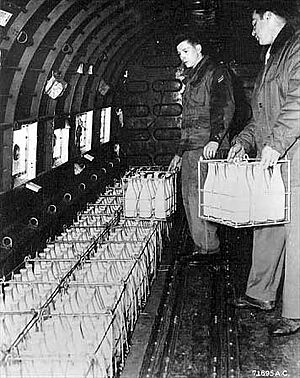
On June 24, 1948, the Soviet Union blocked all land and water routes into the Western parts of Berlin. This meant no trains, trucks, or boats could get through. The Western powers had agreements with the Soviets that said they could use these routes.
General Lucius D. Clay, who was in charge of the U.S. zone, wanted to send tanks to Berlin. He wanted them to fight if they were stopped. But President Harry S. Truman said no, because it could start a war. Instead, they decided to try flying supplies into Berlin. General Albert Coady Wedemeyer, who had experience with airlifts in Asia, supported the idea.
The first airlift flight happened on June 26, 1948. Thirty-two C-47 cargo planes carried 80 tons of milk, flour, and medicine.
So many supplies were needed that planes took off every three minutes. If a plane missed its landing, it couldn't try again. It had to fly back to its base. This kept the air traffic moving smoothly and safely.
The Americans even hired former German aircraft mechanics to help. They realized the blockade would last longer than a few weeks.
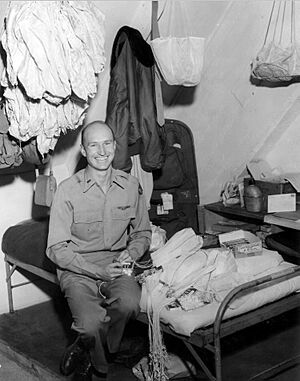
Pilots from Britain, the U.S., Australia, Canada, New Zealand, and South Africa all helped with the airlift. France was busy with other conflicts, so they built a new, larger airport in their sector. It was finished in less than 90 days and is now Berlin-Tegel International Airport.
Hundreds of aircraft were used. Berliners called them Rosinenbomber ("raisin bombers"). This was because some pilots, like U.S. Air Force pilot Gail Halvorsen, dropped small packets of candy with tiny parachutes for the children of Berlin.
In total, there were 278,228 flights. They delivered 2,326,406 tons of food and supplies, including over 1.5 million tons of coal.
The Soviet Union finally ended the blockade on May 11, 1949. However, the airlift continued until September 30, 1949. The Western countries wanted to build up enough supplies in West Berlin in case the Soviets tried another blockade.
The main airports used were Tempelhof (American), RAF Gatow (British), and Tegel (French). Air traffic control was at Tempelhof. A new group called the Berlin Air Safety Center (BASC) was also created to keep flights safe. BASC stayed open until 1990, when Germany was reunited.
British contribution to the airlift
The British Royal Air Force (RAF) used about 150 C-47 Dakota planes and 40 Avro Yorks. They also used 10 Short Sunderland flying boats. These flying boats were good for carrying salt, which would have rusted other planes. By the end of the blockade, the British had flown in about 100,000 tons of cargo.
A monument to heroes
Sadly, 39 British and 31 U.S. pilots died during the airlift. There is a monument with their names in front of Tempelhof airport. It honors those who gave their lives.
They lost their lives for the freedom of Berlin in service for the Berlin Airlift 1948/49
—Luftbrückendenkmal, Tempelhof
What happened after the blockade?
Tegel airport became West Berlin's main airport. Tempelhof airport has since closed. Gatow airport is no longer used for flights and is now a museum.
Related pages
- Berlin
- East Berlin
- Gail Halvorsen (also known as "Uncle Wiggle Wings the Candy Bomber")
Images for kids
-
C-47 Skytrains unloading at Tempelhof Airport during the Berlin Airlift
-
A C-74 Globemaster plane at Gatow airfield on 19 August with more than 20 tons of flour from the United States
-
An RAF Short Sunderland moored on the Havel near Berlin unloading salt during the airlift
-
Handley Page Hastings on display at the Alliiertenmuseum (Allied Museum), Berlin, Germany
See also
 In Spanish: Bloqueo de Berlín para niños
In Spanish: Bloqueo de Berlín para niños


